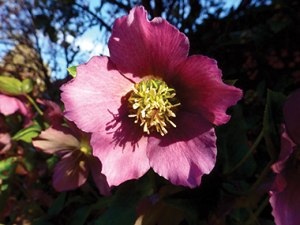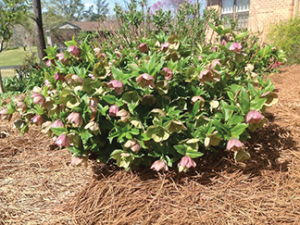Lenten Rose: A Survival Story
Posted on November 1, 2014 by bob in Yard 'N Garden
My mother has had a deep affection for the Lenten rose (officially named Helleborus orientalis), since I gave her one about fifteen years ago. She loves its purplish-pink blooms that appear during the Lenten season preceding Easter, when very little else is blooming in her garden.
On April 27, 2011, my parents’ house in Cullman, Alabama, was in the direct path of the devastating tornado that did much damage to their town. My parents lost almost every tree, bush and flower and even the topsoil from their well-cultivated yard. When it was safe to come out of their house and survey the damage, my mother saw that the only plant left in her beautiful flower bed was her beloved Lenten rose. The plant took on near mystical significance to her after that day, and she began to buy Lenten roses anywhere she could find them in as many colors as she could find. She now has a beautiful bed of these Hellebores in her recovering yard in Cullman.
It’s easy to love Lenten roses. In fact, in 2005, Lenten rose was selected “Plant of the Year” by the Perennial Plant Association. It is lovely, hardy, pest resistant and easily propagated. Once established, Lenten roses readily tolerate drought. They are even naturally deer and rabbit repellent.
Lenten roses typically grow in partial to full shade, although my mother’s plants are in full sun since the tornado, and they have flourished. Clumps establish fairly quickly. To aid plant growth, you can fertilize with a slow-release fertilizer when new foliage begins to appear in late winter. Seedlings will pop up around the clumps as a result of self-seeding and can be replanted to establish new plants.
 Lenten rose leaves are palmate, serrate, leathery, glossy dark green, measuring 8-16 inches in width. The plants are evergreen in warm climates, but deciduous in very cold winters, and have a long 8-10 week blooming period. The petals of the Lenten rose are actually sepals, causing them to last much longer than other flowers.
Lenten rose leaves are palmate, serrate, leathery, glossy dark green, measuring 8-16 inches in width. The plants are evergreen in warm climates, but deciduous in very cold winters, and have a long 8-10 week blooming period. The petals of the Lenten rose are actually sepals, causing them to last much longer than other flowers.
Their flowers can be found in a range of colors: white, lavender, pink, plum, green, dark purple, red and yellow. Although it generally takes three years for a young plant to flower, it is well worth the wait.
This past spring I planted my own Lenten roses in my yard in Montgomery. I have high hopes that mine will bring me the same joy and inspiration that my mother’s have brought her.
Caroline Reddick Lawson, a Master Gardener in the Capital City Master Gardener Association, lives in Montgomery. For information on becoming a master gardener, visit the website, www.capcitymga.org or e-mail capcitymga@gmail.com.









